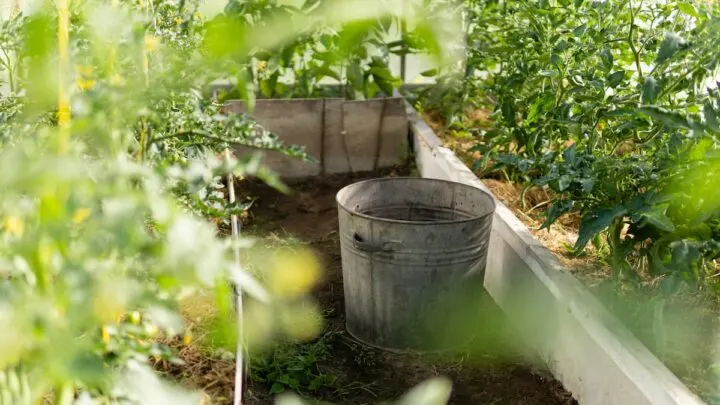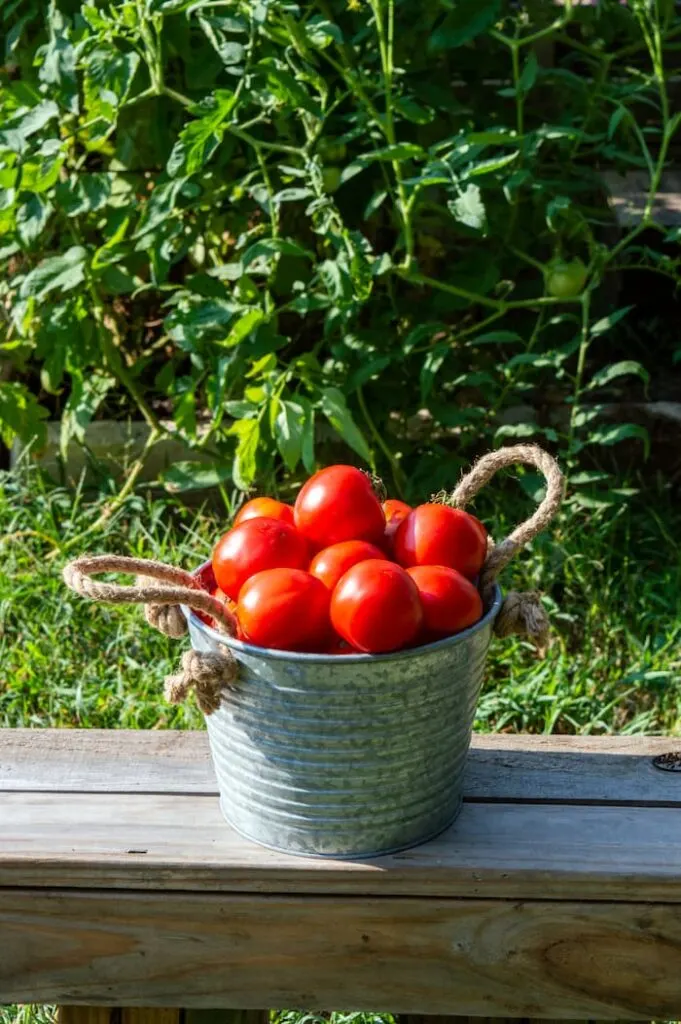Tomato plants can be a great addition to your garden. They’re easy to take care of, making them an excellent plant for beginners to work on their green thumb. Tomato plants can grow pretty large, so it begs the question; can you grow tomatoes in a galvanized bucket?
Galvanized buckets are an excellent choice for growing tomatoes. You need to find a bucket that’s an appropriate size, ensure that there are enough drainage holes, and care for your tomatoes properly. Using a galvanized bucket can be a great way to grow tomatoes in a small space if you do all that.
Read on to learn everything you need to know about growing and caring for your tomatoes in a galvanized bucket.

How To Choose The Right Container For Growing Tomatoes
Tomato plants need a lot of room to grow. If you’re growing tomatoes in a galvanized bucket, then you need to make sure it’s large enough to support your plant and has plenty of drainage holes for watering. Most vegetable plants, including tomatoes, should have plenty of room in a 5-gallon bucket.
You’ll want your container to be made of the right material as well. Containers made of porous materials will lose moisture more easily and won’t be suitable for growing tomatoes. Non-porous materials such as glazed, plastic, metal, and glass are ideal for growing tomato plants.
It’s important to make sure that the container you choose has plenty of drainage holes as well. This will allow your plant to get the proper hydration without becoming over-watered and drowning.
How To Grow Tomatoes In A Galvanized Bucket
Growing tomatoes in a galvanized bucket is a great way to make use of an old container and keep your plant confined. This is a great trick if you don’t have a lot of room outside or the soil where you live isn’t compatible with growing tomato plants. Here are some simple steps you can follow to grow tomatoes in a galvanized bucket.
- Prepare your bucket. Clean it thoroughly with hot soap and water. Rinse until there’s no remaining soap residue. Add a minimum of six drainage holes spaced evenly along the bottom of your container.
- Position your bucket outside. Put it in an area where your plant will receive at least 6 hours of sunlight every day. Place your bucket on top of an object to raise it above ground level so that water can drain easier. You can use bricks, cinder blocks, or even large rocks for this.
- Use an inch of rocks or pebbles to cover the bottom of your bucket. Then, fill your bucket up with potting soil and fertilizer. You want the mixture to stop 1 inch before the top of your container.
- Plant your tomato seeds or seedlings into the mixture. Most tomato plants need about 12 inches of space between each seed, so make sure you’re giving your seeds plenty of room to grow. Add a tomato cage around the seeds to encourage their growth.
- Water your tomato plants every day until the potting soil feels moist. Once your plants start producing tomatoes, pick them once they’re ripe so your plant can continue producing.
There you have it! These five simple steps will help you grow tomatoes in a galvanized bucket.

Is Galvanized Steel Safe For Growing Vegetables
You don’t need to be concerned about growing your vegetables in a galvanized steel container. Galvanizing steel is a process where the steel is coated with zinc to prevent rust and corrosion. The zinc coating won’t affect the growth or taste of your vegetables.
It’s completely safe because the zinc won’t get into your vegetables. Zinc can only be broken down by an acidic reaction, which would require a more intensive process than simply growing your vegetables. Most potting soils or fertilizers are neutral, which won’t affect the zinc coating, so this isn’t something that you need to be worried about.
Are Metal Containers Too Hot For Plants
Metal pots or buckets are more likely to retain an excessive amount of heat than other containers. However, it’s easy to combat this problem with a few tweaks to your gardening routine.
The first thing you can do to help your plant avoid becoming overheated is to water them frequently. You should check the soil in your container at least once a day. Stick your finger down into the soil and if it feels a little dry, immediately water it. Keep your soil moist, but don’t over-water it.
Another way you can help your plant when using metal containers is to add a plant liner. The most effective way to do this is by placing a plastic container inside of your metal one. Make sure there’s about an inch of space between the bottom of your plastic container and the metal bucket or tub. Then, you fill the plastic container with a layer of pebbles, soil, and fertilizer as you would normally. Make sure that the plastic container also has drainage holes along the bottom.
One final tip for keeping your plant from overheating in a metal container is to position it strategically outside. You want it in a place where your plant will get enough sun, about 6 hours for a tomato plant, but won’t be cooking in the sun all day long. Find an area where the shade will protect your plant for part of the day. If your yard doesn’t provide any natural shade, you could even use a tarp to cover your plant for part of the day.

Do Metal Planters Need Drainage Holes
Whether you’re growing tomato plants, other vegetables, or simple flowers in a mental planter, you must ensure you provide enough drainage holes. There should be at least six evenly spaced drainage holes along the bottom of your container.
Drainage holes are necessary to prevent standing water in your planter. Standing water can damage your plants because it’s a breeding ground for bacteria, insects, and other debris that can harm your plant. Proper drainage holes will help keep your plant healthy.
Final Thoughts
If you love gardening and want to try your hand at something different, then using containers can be a fun way to add some shapes and new plants to your garden. Vegetables of all kinds are safe to grow in galvanized buckets, including tomatoes.
Having a happy and healthy plant that produces is easy to accomplish in a galvanized bucket. Follow the simple steps laid out in this guide, and remember to prepare your bucket properly with drainage holes. Don’t forget to position your bucket in an area that will give your plant enough sun without allowing it to become overheated.

Hi there, my name is Allie and welcome to my blog; GareningWithAllie!
Much of what you see written here is just our personal experiences with gardening. Along with the content I write here, there is also a unique collection of gardening topics covered by some of our close friends. I hope you find everything you read here to be helpful, informative, and something that can make your gardening journey the most lovely experience ever! With that said, Happy Gardening!
